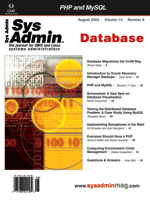 PHP
and MySQL PHP
and MySQL
Russell J.T. Dyer
One of the most popular programming language and database engine
combinations for the Web is PHP with MySQL. This combination works
well for many reasons: primarily the speed, the stability, and the
simplicity of both applications. The two are used extensively on
a variety of Web sites. As a systems administrator, you can use
the pair for storing data on users, hardware, and system documentation,
for example. In this article, I will explain the basics of how to
connect to MySQL and how to query MySQL with PHP.
Connecting to MySQL
The first task for a PHP script that will interface to MySQL is
to make a connection to it, to establish a MySQL session. For the
examples in this article, I will use a database called sys_admin
that I will assume has already been created in MySQL. If you're
unfamiliar with how to create databases in MySQL, check out my MySQL
column archives at UnixReview.com (http://www.unixreview.com/mysql/).
To connect to the database sys_admin, I could begin a PHP
script like so:
<?php
require_once('DB.php');
$user = 'username';
$pw = 'password';
$host = 'localhost';
$db = 'sys_admin';
$dbh = DB::connect("mysql://$user:$pw@$host/$db");
if(DB::iserror($dbh)) {
die($dbh->getMessage());
}
?>
This section of PHP code starts by calling the PEAR DB library, which
typically comes with the basic installation of PHP. If not, you can
get a copy from http://pear.php.net. PEAR, which stands for
"PHP Extension and Application Repository", provides libraries of
common functions. The DB library provides database functions. The
stanza that follows establishes the variables necessary for connecting
to the database. After that, a database handle ($dbh) is created
-- PHP connects to MySQL by giving the user and database variables.
If it's unsuccessful, the script will die with an error message. If
the database handle is successful, though, the database sys_admin
will be selected for use. Each PHP script that is to interface with
MySQL will begin with a section of code like this one.
Querying Data
In my fictitious database, there's a table called computers
that contains information on the office computers and servers. To
retrieve a list of servers and some basic information on them, I'll
begin a PHP script by connecting to MySQL, as shown in the last
script excerpt. That will be followed by the start of a Web page
and then the invoking of an SQL statement to retrieve and display
the data. This can be achieved with code such as the following:
... // Connect to MySQL
<html>
<body>
<h2>List of Servers</h2>
<?php
$sql = "SELECT comp_id, netbios,
location, op_sys
FROM computers
WHERE type = 'server'";
$q = $dbh->query($sql);
if(DB::iserror($q)) {
die($q->getMessage());
}
while($q->fetchInto($row)) {
list($comp_id, $netbios, $location, $op_sys) = $row;
print
"<a href='details.php?comp_id=$comp_id'>$netbios</a>
- $location ($op_sys)<br/>";
}
$dbh->disconnect();
?>
</body>
</html>
After connecting to MySQL (substituted with ellipses here) and starting
the Web page, I then set up a variable ($sql) for the SQL statement.
Using object-oriented programming methods, the database is queried
with the SQL statement. In the next line or so of code, I have an
if statement to see whether an error occurred. If so, the script
will terminate and display an error message.
Assuming PHP was successful in querying the database, I have a
while statement loop through each row of data retrieved from
MySQL. With each pass, using the function fetchInto(), PHP
will temporarily store the columns of data for each row in an array
($row). Within the code block of the while statement,
the list() function parses the elements of the array $row
into the respective variables. I've named these variables to match
their column counter parts. This is not necessary, though; they
may be named anything. I could even use the array as it is and reference
the appropriate sequence number to retrieve data. For instance,
for the operating system value, I could use $row[3] since
it's the fourth in the sequence (0 is first). Naming the variables
as I've done here, though, makes it easier to read the code and
easier for others to follow it later.
The second line of code within the while statement displays
the data in a format necessary for the Web page. The NETbios name
is wrapped in a hyperlink with a reference to another PHP script
(details.php), which will retrieve all of the details for
the particular server selected by a user. That server will be identified
by the computer identification number (i.e., comp_id), which
is a key column for the PHP script details.php that I would
create later. The value for comp_id typically will be placed
automatically in a variable by the same name ($comp_id),
regardless of what I name that variable in this script. It's based
on the name given in the hyperlink or anchor tag. This will happen
if the php.ini configuration file has register_globals
set to on. On Unix and Linux systems, this file is located
in the /etc directory. On a Windows system, it's usually
found in the c:\windows directory. If not, then the value
can be referenced using the $_POST associative array in which
all values that are posted or passed to the next script are stored.
In this, case I could retrieve it by using $_POST['comp_id'].
Conclusion
I've only covered how to connect to MySQL with PHP and how to
query a database using a SELECT statement. However, with
these components you can invoke any SQL statement with PHP. There
are several other DB functions that you may want to look into for
fine-tuning a script. If you're new to combining PHP with MySQL,
however, you can initially limit yourself to the basics presented
here and learn more when necessary.
Russell Dyer is a Perl programmer, a MySQL developer, and a
Web designer living and working on a consulting basis in New Orleans.
He is also an adjunct instructor at a technical college where he
teaches Linux and other open source software. He can be reached
at russell@dyerhouse.com. |

